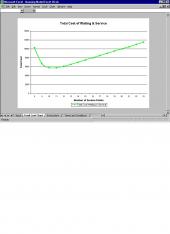Queuing Model Excel 30
Calculate the optimum number of customer service points (staff) to minimize costs for your business. Identify the impact of changes in service staff, the number of customers waiting, their average waiting time, and service point (staff) utilization.
Product Specifications
| User Rating: | item has less then 1 vote |
|
| FileCart Rating | ||
| Submitted by: | bizpeponline | |
| Homepage | Visit Homepage | |
| License | Demo | |
| Price | $69.00 | |
| Downloads | 746 | |
| OS Support | Windows Install and Uninstall | |
| File Name | qme.zip | |
| File Size | 0.29 MB ( 293 KB ) | |
| Published | Jun 22, 2004 (21 years ago) | |
| Updated | Dec 24, 2013 (12 years ago) | |
Follow Us!
Latest Searches
retail stock count assistant jobs 8 minutes ago
windows 11 2 bildschirm wird nicht erkannt 9 minutes ago
nibiru creator 10 minutes ago
ai generator twerk no sign in free 10 minutes ago
como tornar o google buscador padrão 12 minutes ago
Schoberová, V. (2021). Suprasegmental Features in Teaching. [Bachelor’s Thesis, Masaryk University]. Masarykova univerzita. 13 minutes ago
pharmacie ouvert 19 minutes ago
20mm mk41 barrel 23 minutes ago
What two Cisco MDS platforms support FCIP? (Choose two.)Cisco MDS 9700 with 32 Gbps moduleCisco MDS 9700 with 64 Gbps moduleCisco MDS 9700 with SAN Extension moduleCisco MDS 9100Cisco MDS 9220iCisco MDS 9300 28 minutes ago
Popular Searches
id cards 602 times
2025 393 times
2024 385 times
Softperfect 316 times
Database Workbench Pro 258 times
TeraByte Drive Image Backup and Restore 255 times
Elcomsoft Phone Breaker 251 times
Elcomsoft Phone Viewer 232 times
SAM Broadcaster Cloud 223 times
Product Details
| Requirements: | Microsoft Excel |
| Release Info: | Minor Update on Apr 29, 2010 |
| Release Notes: | Evaluation Mode with Excel 2007 and Excel 97-2003 versions. |
| Related Tags: | queue queuing model customer staff |
Reviews
Reviews of Queuing Model Excel 30
You can be the first to write a review of Queuing Model Excel!Other products submitted by this publisher
Forecast the impact of billing fee changes on Revenue, Profit and Client numbers. From basic billing and cost data billing change breakeven points are calculated for revenue and profit and you can build a forecast your business.
Budget Compiler QuickBooks ExcelApply QuickBooks Profit and Loss data to a flexible Excel layout that automates budget creation and can be imported to the QuickBooks budget. This enhances budget development, and provides significant time saving and budget creation.
Budget Tool Business ExcelStreamlined budget creation for up to five years. Full flexibility allowing you to add Revenue, Variable Cost, and Fixed Cost categories and lines to suit any business. Preset formulas minimize inputs and provide display by month, quarter, or year.
Business Valuation Model ExcelBusiness valuation software with a 3 year performance forecast, sensitivity analysis, investment return, and calculated business valuation. Easy to use input interface with tabular and graphical outputs. Quick and effective result, minimal input.
Decision Assistant Model ExcelThe Decision Assistant values a decision and determines the impact on your business. It allows you to measure and monitor decision outcomes. The model supports planning, budgeting, goal setting, investment analysis, and operational improvement.
Most Viewed Windows Personnel Management
Absence Management System 6.1.0.2851
EIOBoard In Out Board 7.0
AllMyNotes Organizer Portable 3.16
EssentialPIM Pro 7.54
In-Out Board 2.1
Employee Training Manager Professional 2013.02.02.15
A VIP Organizer 2.9.66
iMagic Hotel Reservation 6.15
Human Resource Manager Professional 2013.02.02.13
Most Downloaded Windows Personnel Management
AllMyNotes Organizer Portable 3.16
EIOBoard In Out Board 7.0
EssentialPIM Pro 7.54
Contact Organizer Pro 3.2b
iMagic Hotel Reservation 6.15
In-Out Board 2.1
Employee Training Manager Professional 2013.02.02.15
CyberMatrix In Out Scheduler 4.00
A VIP Organizer 2.9.66
